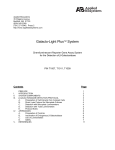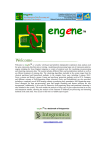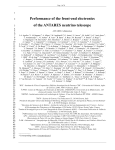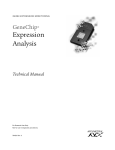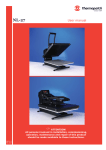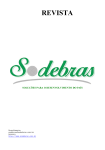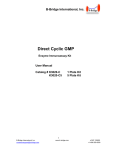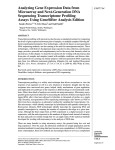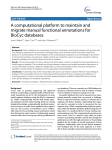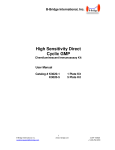Download AffyMiner - a Tool for Significant Gene Mining in Affymetrix
Transcript
Proceedings of the 40th Hawaii International Conference on System Sciences - 2007 AffyMiner – a Tool for Significant Gene Mining in Affymetrix GeneChip Microarray Data Guoqing Lu1*, The Nguyen2, Yuannan Xia2, Zhaoyi Wang3, Mike Fromm2 1 Department of Biology, University of Nebraska at Omaha, Omaha, NE 68182 Center for Biotechnology, University of Nebraska - Lincoln, Lincoln, NE 68588 3 Cancer Center, Creighton University, 2500 California Plaza, Omaha, NE 68178 2 *[email protected] for GL Abstract Microarray technology has revolutionized molecular biology. The challenge associated with this high-throughput technology is how to analyze and make biological sense of a large amount of microarray data. We introduce AffyMiner, a tool developed for detecting differentially expressed genes from Affymetrix GeneChip microarray data and connecting gene annotation and gene ontology information with the genes detected. AffyMiner consists of three functional modules: GeneFinder for finding significant genes in a treatment versus control experiment; GOTree for mapping genes of interest onto the Gene Ontology (GO) space; and interfaces for running Cluster, a program for clustering analysis, and GenMAPP, a program for pathway analysis. AffyMiner effectively deals with multiple replicates in the experiment, provides users the flexibility of choosing different data metrics for finding differentially expressed genes, and is capable of incorporating various gene annotations. AffyMiner has been used for the analysis of GeneChip data described in several publications and has been found to reduce the time and effort needed to compare data from multiple arrays and to interpret the results in terms of gene and cell functions. 1. Introduction DNA microarrays are a powerful tool for monitoring the expression of tens of thousands of genes simultaneously [1]. Affymetrix GeneChips are widely used microarrays with a collection of 11 - 20 probe pairs called a probe set that measures the expression of each transcript. The probe pairs comprise a perfect match (PM) and a single base mismatch (MM) to the target mRNA region. GeneChip microarrays use a statistical algorithm in Microarray Suite 5.0 (MAS 5.0; Affymetrix) to estimate the variance among probe pairs within a probe set and to compute an expression index that represents transcript abundance [2]. The MAS 5.0 algorithm uses the One-Step Tukey’s Biweight Estimate to compute the Signal intensity for each probe set, and employs the Wilcoxon signed-rank test to assess the Detection calls and p-values for a single array analysis [3, 4]. The algorithm uses normalization and scaling techniques to correct for variations between two arrays [5]. The comparison analysis of two arrays results in data matrices such as Change p-value, Change, and Signal Log Ratio. In the case of replicate sample analysis, the two sample statistical tests such as the Student t-test or the Mann-Whitney test can be used to test the hypothesis whether the signal intensity values for each probe set are significantly different in the treatment group compared with the control group. Such statistical tests are not ideal for finding significant genes, because only a few replicate samples (< 4) are usually used in the microarray experiments. Determining the most appropriate statistical method for detecting differentially expressed genes in GeneChip replicate data remains a challenging issue. Several methods have been developed to improve the sensitivity and selectivity for detecting significant genes in GeneChip microarray experiments. The widely used algorithms include the robust multiarray average (RMA) [6], the model based expression index/intensity (MBEI) implemented in dCHIP software [7], and the positional dependent nearestneighbor model (PDNN) [8]. These algorithms effectively deal with the ‘probe effect’, that is, some probes in a probe set tend to give higher values than others [2], through re-computing of the signal intensity 1530-1605/07 $20.00 © 2007 IEEE 1 Proceedings of the 40th Hawaii International Conference on System Sciences - 2007 for each probe set using the processed image data exported from Affymetrix Microarray Suite or GeneChip Operating Software (GCOS). These methods rely solely on quantitative data, i.e., signal intensity values for comparison analysis. Qualitative data such as signal Detection are important parameters in making decisions of which genes are significant. A recent study showed that using the number of Present calls as a threshold could ultimately eliminate unreliable genes while preserving the most significant genes in the result [9]. A joint use of qualitative data Change calls and quantitative data - fold change and signal mean ratios also demonstrated false positives were greatly reduced, whereas the use of a single parameter has a false positive rate more than 30% [10]. Here we introduce a software tool called AffyMiner that uses both quantitative and qualitative data metrics for detecting differentially expressed genes in GeneChip data. In addition, AffyMiner has functions for associating gene annotation information and Gene Ontology (GO) descriptions with significant genes detected that provide better biological interpretations of the results. 2. Software 2.1. Design 2.1.1. User requirements. The requirements established from discussions with the users of our Microarray Core Facility over the past three years include: x Making use of rich data metrics generated by the Affymetrix system. x Providing flexibility for the user to choose different data metrics and different threshold values for filtering for differentially expressed genes. x Incorporating statistical analyses for the selection of significant genes. x Facilitating exploratory analyses such as clustering analysis. x Incorporating information from Gene Ontology and metabolic pathways. x Easy-to-use graphical interfaces. 2.1.2 Architecture. Based upon the user requirements and our experience in using commercial and open source microarray analysis programs such as GeneSpring (http://www.agilent.com/chem/genespring) and Bioconductor [11], we designed AffyMiner to include three functional modules: GeneFinder, GOTree, and interfaces to third-part programs (Figure 1). These modules can analyze GeneChip data separately or consecutively. For example, the gene list generated by GeneFinder can be used by GOTree or Cluster for further analysis. Two popular open source software programs, Cluster and GenMAPP, were chosen for clustering and pathway analyses, respectively. Figure 1. The Architecture of AffyMiner. 2.2. Algorithms 2.2.1 GeneFinder. The algorithm implemented in GeneFinder uses both qualitative and quantitative measures of transcript performance, including Detection, Change, Signal Log ratio, and the statistical results. To determine significantly up-regulated genes in an experiment with multiple replicates of treatment and control samples, the following steps are used: 1) eliminate the probe sets with signal Detection calls of “Absent” in the treatment samples; 2) select the probe sets with signal Change calls of “Increase”; 3) eliminate the probe sets with Signal Log Ratios below a threshold defined by the user; and 4) remove the probe sets with change directions being “down” or pvalues above a threshold defined by the user (Figure 2). The algorithm for detecting significantly downregulated genes is similar to the algorithm above but with differences as described below: 1) eliminate the probe sets with signal Detection calls of “Absent” in the control samples instead of treatment samples; 2) select the probe sets with signal Change calls of “Decrease” rather than “Increase”; 3) eliminate the probe sets with Signal Log Ratios above instead of below a threshold; and 4) remove the probe sets with change directions being “up” instead of “down.” The algorithm for annotating genes is simple. Probe set IDs appearing in both the gene annotation file and the gene list are used to link gene annotation information with quantitative and qualitative data of significant genes. 2.2.2. GOTree. The Gene Ontology (GO) Consortium produces structures of biological knowledge using a controlled vocabulary consisting of GO terms [12]. GO 2 Proceedings of the 40th Hawaii International Conference on System Sciences - 2007 terms are organized into three general categories, biological process, molecular function, and cellular component. The terms within each category are linked in defined parent-child relationships that reflect current biological knowledge. All genes from different organisms are systematically associated with GO terms, and these associations continue to grow in complexity and detail as sequence databases and experimental knowledge grow [13]. GO provides a useful tool to look for common features shared within a list of genes. The high-level description of the algorithm in building the GO tree is as follows, 1) read the output file generated by GeneFinder; 2) write in an array the GO IDs and their corresponding Affymetix probe set IDs; 3) find the GO Path IDs for each GO ID in the array and add the GO Path IDs to each element in the array; 4) sort by the GO Path IDs and compute the sum of the probe sets associated with each node; 5) build the entire tree based on the GO Path IDs and write in each node the GO term, GO ID, and the number of probe sets. Figure 2. The algorithm for detecting up-regulated genes 2.3. AffyMiner AffyMiner includes GeneFinder, GOTree, and interfaces to Cluster and GenMAPP as shown in the main window of AffyMiner (Figure 3). Brief descriptions of AffyMiner and its modules are also available in this window. To illustrate the functions of AffyMiner, we will use Affymetrix Drosophila Genome 2.0 array data generated in the aging experiment with caloric restricted Drosophila, kindly provided by Dr. L. Harshman at the University of Nebraska-Lincoln. Figure 3. The main window of AffyMiner 2.3.1. GeneFinder. GeneFinder has two programs: Significant Genes for finding differentially expressed genes satisfying the user defined criteria and Annotation for linking gene annotation information with the gene list. The Significant Genes program has interactive interfaces to set up parameters, upload input files, and define columns in the output table output, respectively. The parameter-setting window contains three frames for setting up the number of replicates, the direction of a robust change, and the data metrics for detecting differentially expressed genes. AffyMiner limits the maximum number of replicates to five. This is a reasonable assumption because the reproducibility of Affymetrix GeneChip array data is high and most publications use two to three replicates in their experiments. The data metrics consist of Signal Detection, Signal Change, Signal Log Ratio and Statistical Test. The user can choose the data matrices and threshold values for each analysis. As shown in Figure 4, three treatment replicates and three control replicates were used for example analysis. The radio button Increase was checked, which means the task was to find significantly upregulated genes. In the frame “Please select the criteria for filtering significant genes”, checkboxes are used to select which criteria are applied when filtering the genes. The signal detection level was set 3, meaning the Present calls in the signal detention value are required to be present in all the 3 treatment replicates. The number of signal Change calls was set 8, which means that at least 8 Increases are required in the 9 3 Proceedings of the 40th Hawaii International Conference on System Sciences - 2007 Change calls for any given probe sets considered to be significant. The threshold for average signal log ratio was set 0.5, which requires about a 1.4-fold increase of the signals in the treatment samples compared with the control samples. The p-value for the statistical significance was set 0.05. The above settings can be changed dynamically. probe set IDs. Once these two files are uploaded, the columns in the output table can be chosen from the list box interface. Figure 5. Input setting window. Figure 4. Parameter setting window The next step is to upload input file and select columns corresponding to specific samples (i.e., treatment and control) and data metrics (Figure 5). The input file is a text file exported from Affymetrix GCOS, containing results of single array analyses and pairwise array comparison analyses. If Significant Test checkbox was checked in the parameter setting window (Figure 4), the results of statistical tests need to be added to the text file with two columns corresponding to the p-value and change direction, respectively. The change direction is specified as “up” for up-regulated genes and “down” for down-regulated genes. Clicking “Back” button returns to the first window if parameter settings need to be changed. Clicking “Search” button starts analysis process. Figure 6 shows significant genes found by Significant Genes program in GeneFinder. The Annotation program links the annotation information with gene lists, and generates a userdefined table with quantitative data such as signal log ratio and annotation information. The NetAffx annotation file needs to be in the CSV (Comma Separated Value) format, which can be downloaded from the Affymetrix website (http://www.affymetrix.com/). The gene list input file can be the result generated by Significant Genes or any text file with a column corresponding to Affymetrix Figure 6. Differentially expressed genes found by the Significant Genes program in AffyMiner The table resulting from the Annotation step is shown in Figure 7, where Average Signal Log Ratio, Target Description, Gene Title, Gene Ontology, and Protein family were selected. This table can be included in publications with no need for further editing. 2.3.2. GOTree. GOTree takes as input two files. The first file called GOPath consists of the information about the hierarchical structure of GO terms, whereas the second file contains the list of significant genes and their GO term associations. The GOPath file was generated from the ChipInfo program, which can be downloaded from the web. (http://www.biostat.harvard.edu/complab/chipinfo/) [14]. To run ChipInfo, the gene information file downloaded from the Affymetrix website is required. 4 Proceedings of the 40th Hawaii International Conference on System Sciences - 2007 http://www.genmapp.org/download.asp to download Cluster and GenMAPP, respectively. In the main window, clicking the button “Set Path ...” will set up the path to the corresponding program file (Figure 3). Clicking the button Cluster or GenMAPP will run the program for analysis. 2.4. Implementation, Availability Figure 7. Annotation table resulting from the Annotation program in AffyMiner The GO tree generated from AffyMiner is shown in Figure 8. Each node is labeled with the corresponding GO term, GO ID, and the number of genes associated. For example, line 3 of the Gene Ontology tree as shown in Figure 8 indicates the node represents behavior in biological process with GO ID 7610 and 2 probe sets on the significant gene list associated with this GO term. The tree can be expanded or clipped by clicking on the small square boxes. A window displaying the Affymetrix IDs associated with the GO term will pop up when the number is right clicked. Installation, and 2.4.1. Implementation. AffyMiner was developed in the Microsoft .Net platform and programmed in Visual Basic .Net. 2.4.2. System requirements. The minimum requirements to run AffyMiner include a Pentium 3 or later computer, 512 MB of Memory, Windows 2000 or later operating system, and .NET Framework 2.0 or later. 2.4.3. Installation. To install AffyMiner, double click on AffyMinerInstaller.msi and follow the instructions. AffyMiner requires .NET Framework 2.0 or later installed on the computer, which can be downloaded from our website at http://bioinfosrv1.awh.unomaha.edu/affyminer/. Or Microsoft web site at http://msdn.microsoft.com/netframework/. 2.4.4. Availability. AffyMiner is available for download at http://bioinfosrv1.awh.unomaha.edu/affyminer/. The user manual can be found from our website as well. 3. Case studies AffyMiner has been tested by multiple users and their feedback has been incorporated into its current features [15, 16]. In the following example, we describe two case studies using AffyMiner to find differentially expressed genes, one related to nutritional genomics and the other to cancer informatics. 3.1. Inflammation and delipidation of white adipose tissue in mice Figure 8. An example Gene Ontology tree generated by AffyMiner 2.3.3. Interfaces to Cluster and GenMAPP. Both Cluster and GenMAPP programs need to be downloaded and installed on the local computer (see below for the system requirements of the computer). Go to the websites, http://rana.lbl.gov/EisenSoftware.htm and Our group (YX and MF) studied the gene expression changes in the retroperitoneal white adipose tissue (RP-WAT) in mice fed trans-10, cis-12 conjugated linoleic acid (t10c12 CLA) [17]. The Affymetrix Mouse Genome 430 2.0 microarrays were used to detect the expression changes of about 34,000 transcripts. Mice were sampled 1, 2, 3, 4, 7, 10, or 17 days after being fed control or 0.5% t10c12 CLA diets, generating 7 time points in total. At each time point, the RP-WAT tissues of ten control and ten t10c12 CLA-fed mice were harvested in groups of five mice each to provide two control and two treatment samples for microarray analysis. 5 Proceedings of the 40th Hawaii International Conference on System Sciences - 2007 To detect differentially expressed genes the transformed RMA expression values were analyzed using an empirical Bayes Linear model [18, 19]. A total of 5408 genes were found significant on Day 1 by the RMA approach. We used the same dataset and ran AffyMiner with the following parameter settings: for increase, 2 Present calls in the treatment samples, 3 Increase calls for signal change, average signal log ratio being 0.5; for decrease, 2 Present calls in the control samples, 3 Decrease calls for signal change, average signal log ratio being -0.5. AffyMiner found 4089 differentially expressed genes. The number of overlap genes found by AffyMiner and RMA is 2946 (Table 1). The discrepancy of the gene lists is contributed mainly to the differences of algorithms underlying AffyMiner and RMA. This observation is consistent with a recent comparison of six different algorithms, where only 27 to 36% overlap were found between different methods [20]. On the other hand, all the ten genes validated by the quantitative RT-PCR were found by AffyMiner, which indicates that incorporating qualitative data metrics might increase the selectivity of detecting differentially expressed genes. Į66 and hER-ȕ. To further investigate the molecular mechanisms by which hER-Į36 functions during breast cancer development, we conducted microarray experiments to profile estrogen responsive genes in the ER-positive human breast cancer line MCF7 that highly express recombinant hER-D36 as contrasted to the parent MCF7 cells in the absence or presence of estrogen. Affymetrix Human GeneChip Genome U133 Plus 2.0 Array was used, which contains over 47,000 transcripts. Experimental settings follow standard procedures as described previously [17]. AffyMiner was used to identify significant genes with different expression patterns in these cells in the absence or presence of estrogen. We used the same parameter settings as in 3.1. A total of 2162 and 1507 genes were found differentially expressed in 12 hour estrogen treatment for the parental MCF7 cells and hER-D36 expressing MCF7 cells, respectively. We are currently performing in-depth pathway and ontology analysis, and the results will be presented elsewhere. Table 1. Differentially expressed genes found by AffyMiner and RMA Microarray technology has revolutionized the analysis of gene expression. The challenge associated with this high throughput technology is the statistical analysis and biological interpretation of microarray data. AffyMiner was developed to address these issues through finding genes with significant changes in gene expression, and linking these genes with the annotation and Gene Ontology information. Functionally, AffyMiner has overlap with other existing programs, but has the distinguishing features discussed below. Affymetrix Data Mining Tool (DMT) can filter genes of interest based on the thresholds of certain quantitative and qualitative parameters, but not as powerful as AffyMiner in this aspect. AffyMiner takes full advantage of the range of the different data metrics available from MAS 5.0. AffyMiner provides the flexibility to choose different data metrics (Signal Detection, Signal Change, Signal Log Ratio, and Statistic Test) and to set threshold values for analyzing differentially expressed genes. This flexibility is very important since no one single method outperforms others for microarray data analysis [20, 22]. This is apparent from the differences in the gene lists found by the AffyMiner and RMA based methods in the case study. Incorporating qualitative data metrics such as Detection and Signal Change would increase the selectivity of detecting differentially expressed genes [20]. Genes Approach Up-regulated Down-regulated AffyMiner 1927 2162 RMA / Bayesian approach 2530 2877 Common in both 1432 1514 3.2. A novel isoform of estrogen receptor-D (ER-Į36) and breast cancer Understanding the molecular mechanisms by which estrogens drive breast cancer development has long been a challenging issue. Numerous studies demonstrate that the human estrogen receptor-Į (hERĮ66) contributes to development of human breast cancer and is a critical determinant in assessing prognosis as well as designing treatment strategies of breast cancer. Recently, we discovered a novel variant of hER-Į66, termed hER-Į36[21]. The hER-Į36 lacks both transcriptional transactivation domains, AF-1 and AF-2 but functions to inhibit the ligand-dependent and ligand-independent transactivation activities of hER- 4. Discussion 4.1. Software comparison 6 Proceedings of the 40th Hawaii International Conference on System Sciences - 2007 GenePicker [10] has certain functions similar to those in AffyMiner. GenePicker was developed for the analysis of replicates of Affymetrix gene expression microarrays. The GenePicker analysis is done through defining analysis schemes, data normalization, ttest/ANOVA, and Change-fold Chang-analysis, and the use of Change Call, Fold Change, and Signal mean ratios. GenePicker provides a comparison of noise and signal analysis scheme for determining a signal-tonoise in a given experiment, which is not available in GeneFinder. However, GeneFinder uses one more data matrix, i.e., Detection. As mentioned earlier, GeneFinder also has the function of incorporating gene annotation information with expression data, which is not available in GenePicker. The Affymetrix NetAffx Gene Ontology Mining Tool can create a graph of GO terms associated with the input probe sets. However, the graph is very difficult to read as compared with the one generated by AffyMiner (Figure 7). AffyMiner has the flexibility of displaying the GO tree at different levels and the probe sets associated with the GO terms can be viewed easily. Another GO tool called GoSurfer was developed for the GO analysis of Affymetrix GeneChip data [7, 13, 14]. GoSurfer associates user input gene lists with GO terms and visualizes such GO terms as a hierarchical tree. GoSurfer compares two lists of genes in order to find which GO terms are enriched in one list of genes but relatively depleted in another. GoSurfer can not map genes from a single list onto the GO descriptions. In this regard, GOTree and GoSurfer complement each other in the analysis of Gene Ontology. of incorporating various gene annotations. AffyMiner has been used for analyzing the GeneChip data for several publications, which has facilitated comparing data from multiple arrays and interpreting the possible biological implications associated with significant changes in a gene’s expression. 6. Acknowledgements This publication was made possible by NSF Grant Number EPS-0346476 from the NSF EPSCoR program and by NIH Grant Number P20 RR16469 from the INBRE Program of the National Center for Research Resources. GL acknowledges the Pre-tenure Award from University of Nebraska at Omaha. The authors are grateful to a number of users for providing feedbacks on AffyMiner. 4.2. Limitations AffyMiner is a Windows application. It runs only on computers using Microsoft Windows 2000 or above. In addition, AffyMiner relies on the Affymetrix MAS 5.0 algorithm for the low-level analysis in the single array analysis and pairwise comparisons, and NetAffx for gene annotation information. We recommend the user check the NetAffx website frequently and use the latest annotation file for analysis. 5. Conclusions As a whole, AffyMiner fills an important gap in finding differentially expressed genes from Affymetrix GeneChip microarray data. AffyMiner effectively deals with multiple replicates in the experiment, provides users flexibility choosing different data metrics for detecting significant genes, and is capable 7 Proceedings of the 40th Hawaii International Conference on System Sciences - 2007 7. References [1] [2] [3] [4] [5] [6] [7] [8] [9] [10] [11] D. J. Lockhart, H. Dong, M. C. Byrne, M. T. Follettie, M. V. Gallo, M. S. Chee, M. Mittmann, C. Wang, M. Kobayashi, H. Horton, and E. L. Brown, "Expression monitoring by hybridization to high-density oligonucleotide arrays," Nat Biotechnol, vol. 14, pp. 1675-80, 1996. J. D. Clarke and T. Zhu, "Microarray analysis of the transcriptome as a stepping stone towards understanding biological systems: practical considerations and perspectives," Plant J., vol. 45, pp. 630-50, 2006. E. Hubbell, W. M. Liu, and R. Mei, "Robust estimators for expression analysis," Bioinformatics, vol. 18, pp. 1585-92, 2002. W. M. Liu, R. Mei, X. Di, T. B. Ryder, E. Hubbell, S. Dee, T. A. Webster, C. A. Harrington, M. H. Ho, J. Baid, and S. P. Smeekens, "Analysis of high density expression microarrays with signed-rank call algorithms," Bioinformatics, vol. 18, pp. 1593-9, 2002. Affymetrix, "GeneChip expression analysis data analysis fundamentals," 2006. R. A. Irizarry, B. M. Bolstad, F. Collin, L. M. Cope, B. Hobbs, and T. P. Speed, "Summaries of Affymetrix GeneChip probe level data," Nucleic Acids Res, vol. 31, pp. e15, 2003. C. Li and W. H. Wong, "Model-based analysis of oligonucleotide arrays: expression index computation and outlier detection," Proc Natl Acad Sci U S A, vol. 98, pp. 31-6, 2001. L. Zhang, M. F. Miles, and K. D. Aldape, "A model of molecular interactions on short oligonucleotide microarrays," Nat Biotechnol, vol. 21, pp. 818-21, 2003. J. N. McClintick and H. J. Edenberg, "Effects of filtering by Present call on analysis of microarray experiments," BMC Bioinformatics, vol. 7, pp. 49, 2006. G. Finocchiaro, P. Parise, S. P. Minardi, M. Alcalay, and H. Muller, "GenePicker: replicate analysis of Affymetrix gene expression microarrays," Bioinformatics, vol. 20, pp. 3670-2, 2004. S. Dudoit, R. C. Gentleman, and J. Quackenbush, "Open source software for the analysis of microarray data," Biotechniques, vol. Suppl, pp. 45-51, 2003. [12] [13] [14] [15] [16] [17] M. A. Harris, J. Clark, A. Ireland, J. Lomax, M. Ashburner, R. Foulger, K. Eilbeck, S. Lewis, B. Marshall, C. Mungall, J. Richter, G. M. Rubin, J. A. Blake, C. Bult, M. Dolan, H. Drabkin, J. T. Eppig, D. P. Hill, L. Ni, M. Ringwald, R. Balakrishnan, J. M. Cherry, K. R. Christie, M. C. Costanzo, S. S. Dwight, S. Engel, D. G. Fisk, J. E. Hirschman, E. L. Hong, R. S. Nash, A. Sethuraman, C. L. Theesfeld, D. Botstein, K. Dolinski, B. Feierbach, T. Berardini, S. Mundodi, S. Y. Rhee, R. Apweiler, D. Barrell, E. Camon, E. Dimmer, V. Lee, R. Chisholm, P. Gaudet, W. Kibbe, R. Kishore, E. M. Schwarz, P. Sternberg, M. Gwinn, L. Hannick, J. Wortman, M. Berriman, V. Wood, N. de la Cruz, P. Tonellato, P. Jaiswal, T. Seigfried, and R. White, "The Gene Ontology (GO) database and informatics resource," Nucleic Acids Res, vol. 32 Database issue, pp. D25861, 2004. S. Zhong, L. Tian, C. Li, F. Storch, and W. Wong, "Comparative Analysis of Gene Sets in the Gene Ontology Space under the Multiple Hypothesis Testing Framework," Proc. IEEE Comp Systems Bioinformatics, vol. 2004, pp. 425-435, 2004. S. Zhong, C. Li, and W. H. Wong, "ChipInfo: Software for extracting gene annotation and gene ontology information for microarray analysis," Nucleic Acids Res, vol. 31, pp. 3483-6, 2003. R. Alvarez-Venegas, M. Sadder, A. Hlavacka, F. Baluska, Y. Xia, G. Lu, A. Firsov, G. Sarath, H. Moriyama, J. G. Dubrovsky, and Z. Avramova, "The Arabidopsis homolog of trithorax, ATX1, binds phosphatidylinositol 5-phosphate, and the two regulate a common set of target genes," Proc Natl Acad Sci U S A, vol. 103, pp. 6049-54, 2006. R. Alvarez-Venegas, Y. Xia, G. Lu, and Z. Avramova, "Phosphoinositide 5-Phosphate and Phosphoinositide 4-Phosphate Trigger Distinct Specific Responses of Arabidopsis Genes; Genome-Wide Expression Analyses," Plant Signaling & Behavior, vol. 1, pp. 140151, 2006. P. C. Larosa, J. Miner, Y. Xia, Y. Zhou, S. Kachman, and M. E. Fromm, "Trans-10, Cis12 Conjugated Linoleic Acid Causes Inflammation And Delipidation Of White 8 Proceedings of the 40th Hawaii International Conference on System Sciences - 2007 [18] [19] [20] [21] [22] Adipose Tissue In Mice: A Microarray And Histological Analysis," Physiol Genomics, 2006. G. K. Smyth, Michaud, J., and Scott, H., "The use of within-array replicate spots for assessing differential expression in microarray experiments. Bioinformatics," Bioinformatics, vol. 21, pp. 2067-2075, 2005. G. K. Smyth, "Linear Models and Empirical Bayes Methods for Assessing Differential Expression in Microarray Experiments," Statistical Applications in Genetics and Molecular Biology, vol. 3, pp. Article 3, 2004. F. F. Millenaar, J. Okyere, S. T. May, M. van Zanten, L. A. Voesenek, and A. J. Peeters, "How to decide? Different methods of calculating gene expression from short oligonucleotide array data will give different results," BMC Bioinformatics, vol. 7, pp. 137, 2006. Z. Wang, X. Zhang, P. Shen, B. W. Loggie, Y. Chang, and T. F. Deuel, "A variant of estrogen receptor-{alpha}, hER-{alpha}36: transduction of estrogen- and antiestrogendependent membrane-initiated mitogenic signaling," Proc Natl Acad Sci U S A, vol. 103, pp. 9063-8, 2006. R. Breitling, P. Armengaud, A. Amtmann, and P. Herzyk, "Rank products: a simple, yet powerful, new method to detect differentially regulated genes in replicated microarray experiments," FEBS Lett, vol. 573, pp. 83-92, 2004. 9









